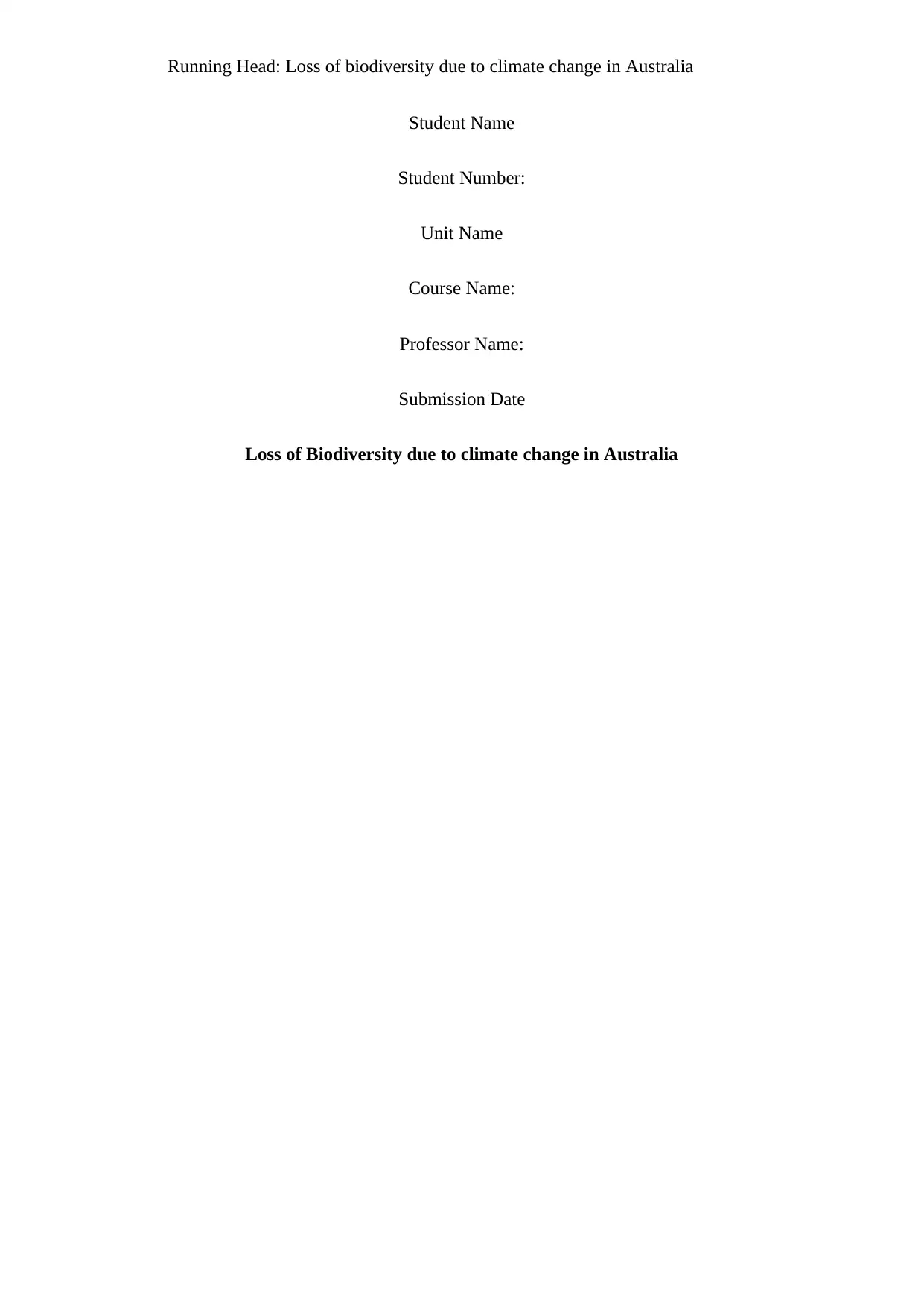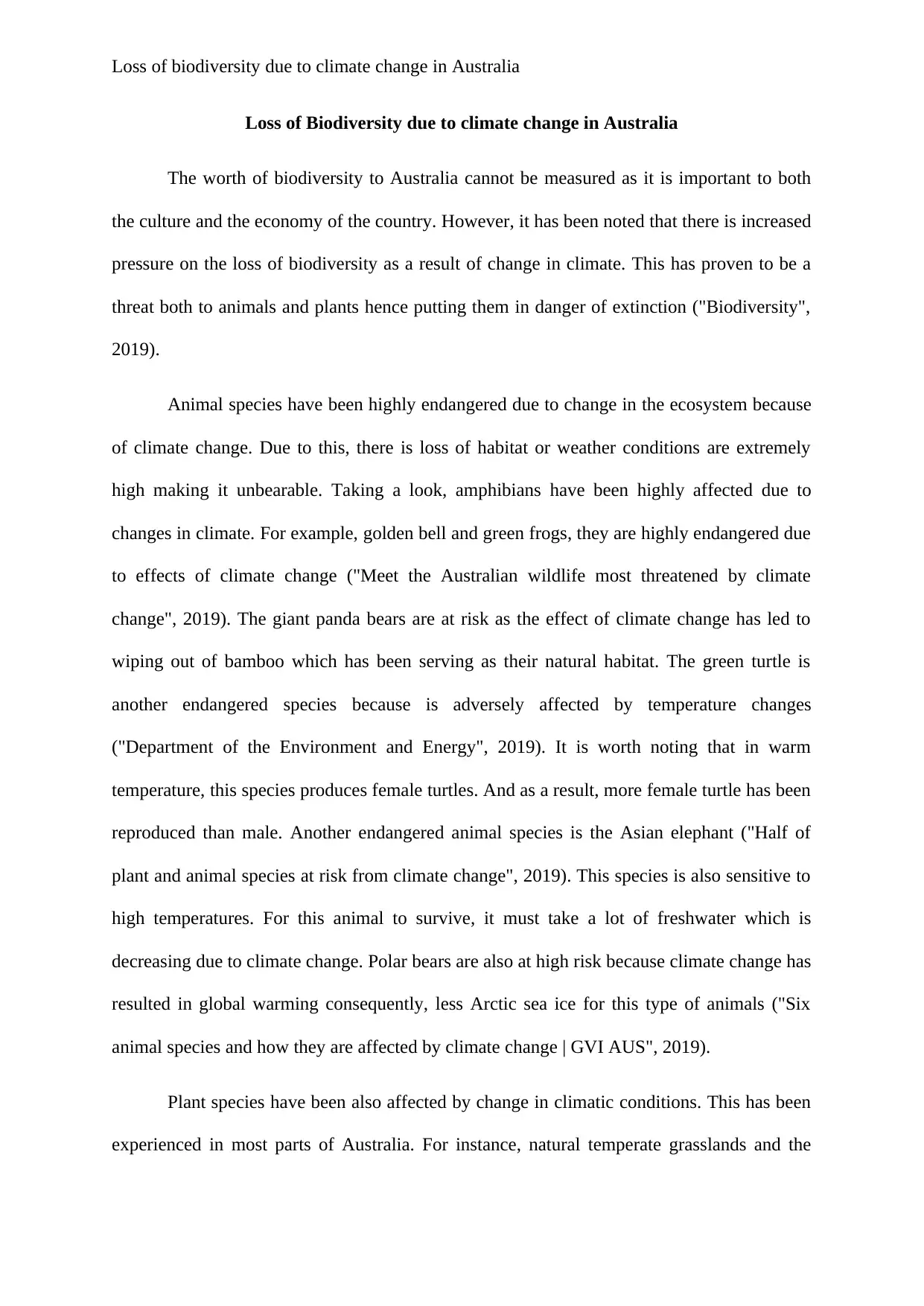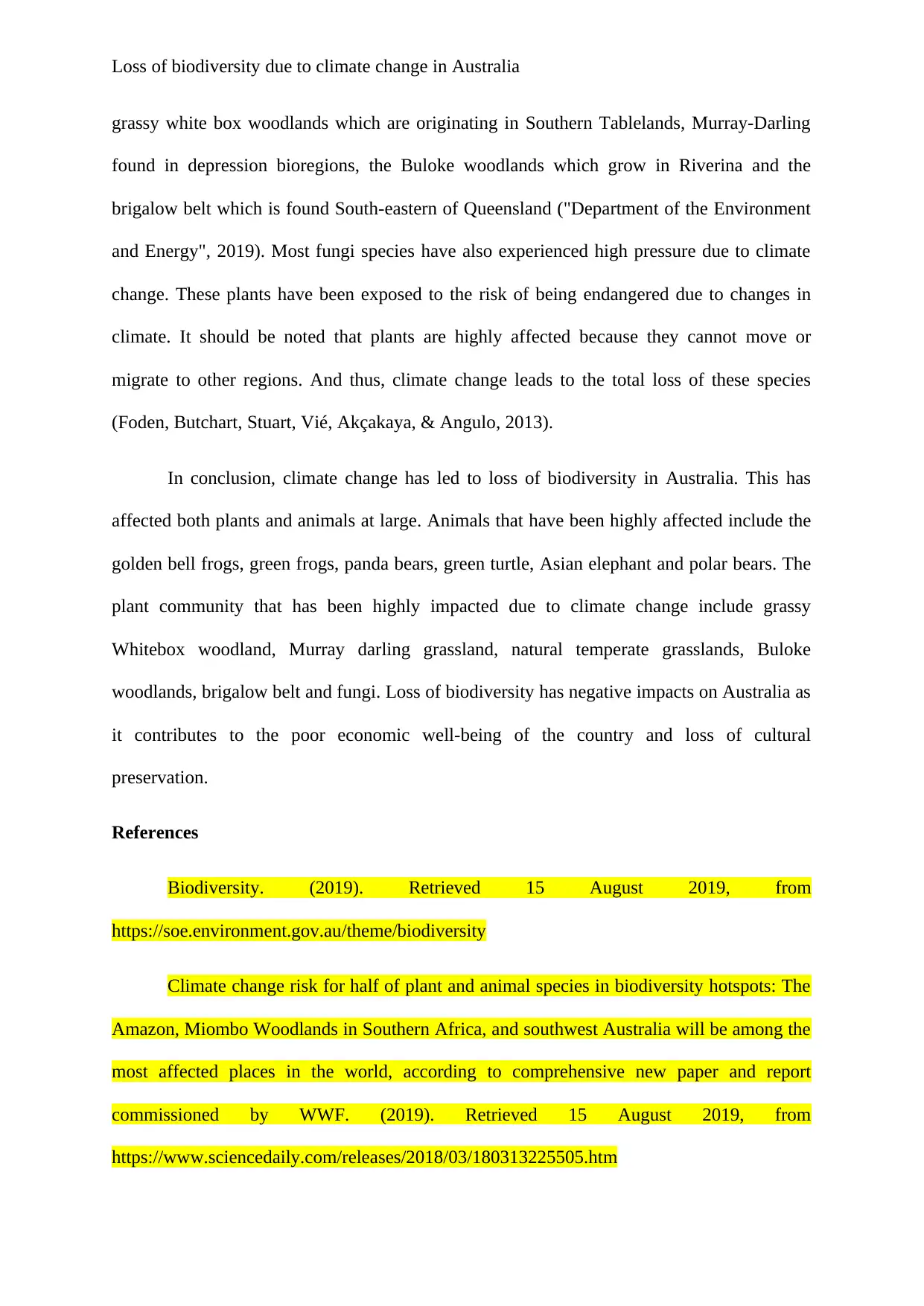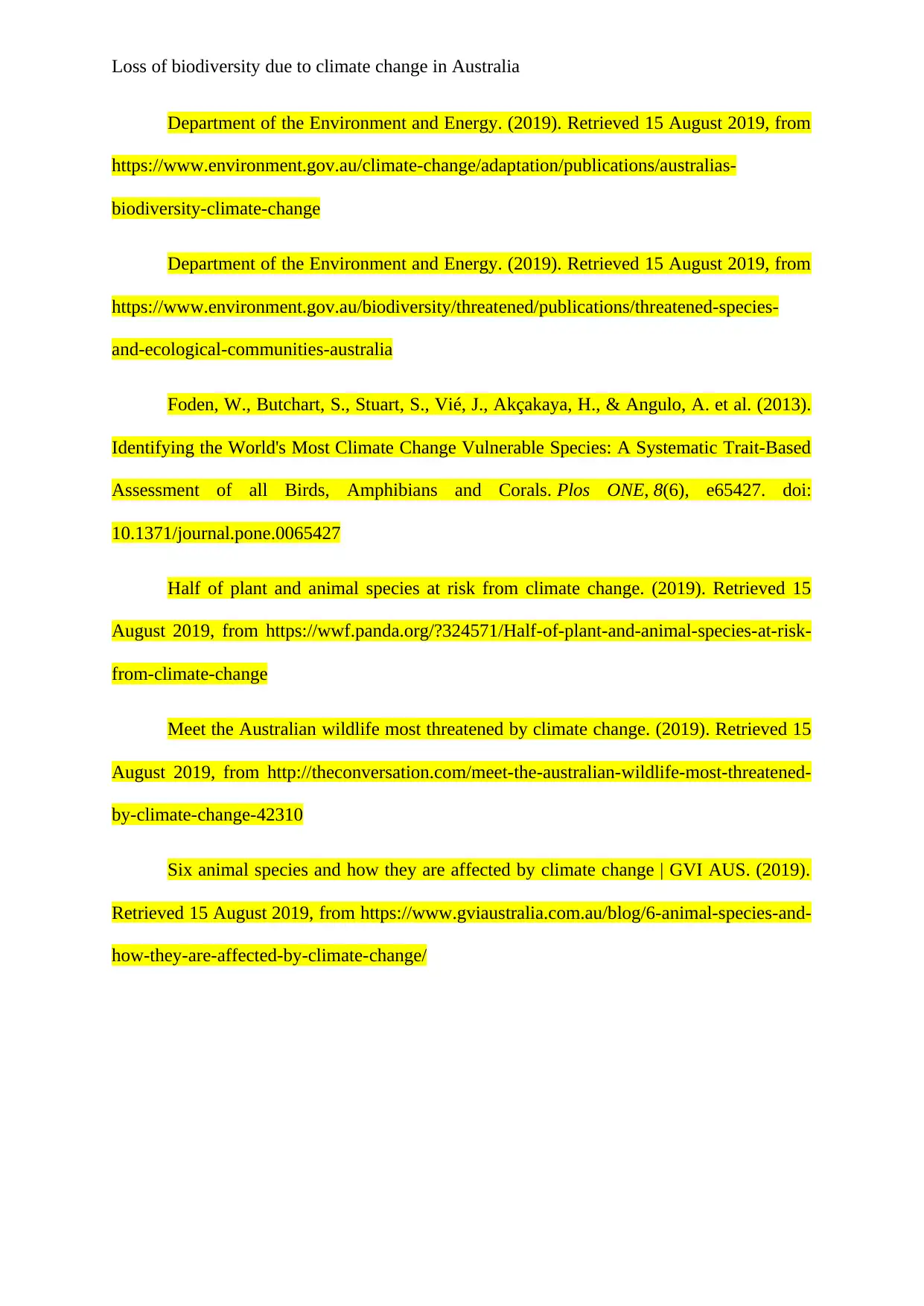Essay: Climate Change and Loss of Biodiversity in Australia
VerifiedAdded on 2022/09/27
|4
|931
|22
Essay
AI Summary
This essay explores the detrimental effects of climate change on biodiversity in Australia. It highlights the vulnerability of various animal species, including amphibians like golden bell and green frogs, panda bears, green turtles, Asian elephants, and polar bears, due to habitat loss and extreme weather conditions. The essay also addresses the impact on plant species, such as natural temperate grasslands and specific woodland types. It emphasizes the inability of plants to migrate, making them highly susceptible to climate change. The conclusion stresses the negative implications of biodiversity loss on Australia's economy and cultural preservation, underscoring the urgency of addressing climate change to protect the country's unique ecosystem and species.

Running Head: Loss of biodiversity due to climate change in Australia
Student Name
Student Number:
Unit Name
Course Name:
Professor Name:
Submission Date
Loss of Biodiversity due to climate change in Australia
Student Name
Student Number:
Unit Name
Course Name:
Professor Name:
Submission Date
Loss of Biodiversity due to climate change in Australia
Paraphrase This Document
Need a fresh take? Get an instant paraphrase of this document with our AI Paraphraser

Loss of biodiversity due to climate change in Australia
Loss of Biodiversity due to climate change in Australia
The worth of biodiversity to Australia cannot be measured as it is important to both
the culture and the economy of the country. However, it has been noted that there is increased
pressure on the loss of biodiversity as a result of change in climate. This has proven to be a
threat both to animals and plants hence putting them in danger of extinction ("Biodiversity",
2019).
Animal species have been highly endangered due to change in the ecosystem because
of climate change. Due to this, there is loss of habitat or weather conditions are extremely
high making it unbearable. Taking a look, amphibians have been highly affected due to
changes in climate. For example, golden bell and green frogs, they are highly endangered due
to effects of climate change ("Meet the Australian wildlife most threatened by climate
change", 2019). The giant panda bears are at risk as the effect of climate change has led to
wiping out of bamboo which has been serving as their natural habitat. The green turtle is
another endangered species because is adversely affected by temperature changes
("Department of the Environment and Energy", 2019). It is worth noting that in warm
temperature, this species produces female turtles. And as a result, more female turtle has been
reproduced than male. Another endangered animal species is the Asian elephant ("Half of
plant and animal species at risk from climate change", 2019). This species is also sensitive to
high temperatures. For this animal to survive, it must take a lot of freshwater which is
decreasing due to climate change. Polar bears are also at high risk because climate change has
resulted in global warming consequently, less Arctic sea ice for this type of animals ("Six
animal species and how they are affected by climate change | GVI AUS", 2019).
Plant species have been also affected by change in climatic conditions. This has been
experienced in most parts of Australia. For instance, natural temperate grasslands and the
Loss of Biodiversity due to climate change in Australia
The worth of biodiversity to Australia cannot be measured as it is important to both
the culture and the economy of the country. However, it has been noted that there is increased
pressure on the loss of biodiversity as a result of change in climate. This has proven to be a
threat both to animals and plants hence putting them in danger of extinction ("Biodiversity",
2019).
Animal species have been highly endangered due to change in the ecosystem because
of climate change. Due to this, there is loss of habitat or weather conditions are extremely
high making it unbearable. Taking a look, amphibians have been highly affected due to
changes in climate. For example, golden bell and green frogs, they are highly endangered due
to effects of climate change ("Meet the Australian wildlife most threatened by climate
change", 2019). The giant panda bears are at risk as the effect of climate change has led to
wiping out of bamboo which has been serving as their natural habitat. The green turtle is
another endangered species because is adversely affected by temperature changes
("Department of the Environment and Energy", 2019). It is worth noting that in warm
temperature, this species produces female turtles. And as a result, more female turtle has been
reproduced than male. Another endangered animal species is the Asian elephant ("Half of
plant and animal species at risk from climate change", 2019). This species is also sensitive to
high temperatures. For this animal to survive, it must take a lot of freshwater which is
decreasing due to climate change. Polar bears are also at high risk because climate change has
resulted in global warming consequently, less Arctic sea ice for this type of animals ("Six
animal species and how they are affected by climate change | GVI AUS", 2019).
Plant species have been also affected by change in climatic conditions. This has been
experienced in most parts of Australia. For instance, natural temperate grasslands and the

Loss of biodiversity due to climate change in Australia
grassy white box woodlands which are originating in Southern Tablelands, Murray-Darling
found in depression bioregions, the Buloke woodlands which grow in Riverina and the
brigalow belt which is found South-eastern of Queensland ("Department of the Environment
and Energy", 2019). Most fungi species have also experienced high pressure due to climate
change. These plants have been exposed to the risk of being endangered due to changes in
climate. It should be noted that plants are highly affected because they cannot move or
migrate to other regions. And thus, climate change leads to the total loss of these species
(Foden, Butchart, Stuart, Vié, Akçakaya, & Angulo, 2013).
In conclusion, climate change has led to loss of biodiversity in Australia. This has
affected both plants and animals at large. Animals that have been highly affected include the
golden bell frogs, green frogs, panda bears, green turtle, Asian elephant and polar bears. The
plant community that has been highly impacted due to climate change include grassy
Whitebox woodland, Murray darling grassland, natural temperate grasslands, Buloke
woodlands, brigalow belt and fungi. Loss of biodiversity has negative impacts on Australia as
it contributes to the poor economic well-being of the country and loss of cultural
preservation.
References
Biodiversity. (2019). Retrieved 15 August 2019, from
https://soe.environment.gov.au/theme/biodiversity
Climate change risk for half of plant and animal species in biodiversity hotspots: The
Amazon, Miombo Woodlands in Southern Africa, and southwest Australia will be among the
most affected places in the world, according to comprehensive new paper and report
commissioned by WWF. (2019). Retrieved 15 August 2019, from
https://www.sciencedaily.com/releases/2018/03/180313225505.htm
grassy white box woodlands which are originating in Southern Tablelands, Murray-Darling
found in depression bioregions, the Buloke woodlands which grow in Riverina and the
brigalow belt which is found South-eastern of Queensland ("Department of the Environment
and Energy", 2019). Most fungi species have also experienced high pressure due to climate
change. These plants have been exposed to the risk of being endangered due to changes in
climate. It should be noted that plants are highly affected because they cannot move or
migrate to other regions. And thus, climate change leads to the total loss of these species
(Foden, Butchart, Stuart, Vié, Akçakaya, & Angulo, 2013).
In conclusion, climate change has led to loss of biodiversity in Australia. This has
affected both plants and animals at large. Animals that have been highly affected include the
golden bell frogs, green frogs, panda bears, green turtle, Asian elephant and polar bears. The
plant community that has been highly impacted due to climate change include grassy
Whitebox woodland, Murray darling grassland, natural temperate grasslands, Buloke
woodlands, brigalow belt and fungi. Loss of biodiversity has negative impacts on Australia as
it contributes to the poor economic well-being of the country and loss of cultural
preservation.
References
Biodiversity. (2019). Retrieved 15 August 2019, from
https://soe.environment.gov.au/theme/biodiversity
Climate change risk for half of plant and animal species in biodiversity hotspots: The
Amazon, Miombo Woodlands in Southern Africa, and southwest Australia will be among the
most affected places in the world, according to comprehensive new paper and report
commissioned by WWF. (2019). Retrieved 15 August 2019, from
https://www.sciencedaily.com/releases/2018/03/180313225505.htm
⊘ This is a preview!⊘
Do you want full access?
Subscribe today to unlock all pages.

Trusted by 1+ million students worldwide

Loss of biodiversity due to climate change in Australia
Department of the Environment and Energy. (2019). Retrieved 15 August 2019, from
https://www.environment.gov.au/climate-change/adaptation/publications/australias-
biodiversity-climate-change
Department of the Environment and Energy. (2019). Retrieved 15 August 2019, from
https://www.environment.gov.au/biodiversity/threatened/publications/threatened-species-
and-ecological-communities-australia
Foden, W., Butchart, S., Stuart, S., Vié, J., Akçakaya, H., & Angulo, A. et al. (2013).
Identifying the World's Most Climate Change Vulnerable Species: A Systematic Trait-Based
Assessment of all Birds, Amphibians and Corals. Plos ONE, 8(6), e65427. doi:
10.1371/journal.pone.0065427
Half of plant and animal species at risk from climate change. (2019). Retrieved 15
August 2019, from https://wwf.panda.org/?324571/Half-of-plant-and-animal-species-at-risk-
from-climate-change
Meet the Australian wildlife most threatened by climate change. (2019). Retrieved 15
August 2019, from http://theconversation.com/meet-the-australian-wildlife-most-threatened-
by-climate-change-42310
Six animal species and how they are affected by climate change | GVI AUS. (2019).
Retrieved 15 August 2019, from https://www.gviaustralia.com.au/blog/6-animal-species-and-
how-they-are-affected-by-climate-change/
Department of the Environment and Energy. (2019). Retrieved 15 August 2019, from
https://www.environment.gov.au/climate-change/adaptation/publications/australias-
biodiversity-climate-change
Department of the Environment and Energy. (2019). Retrieved 15 August 2019, from
https://www.environment.gov.au/biodiversity/threatened/publications/threatened-species-
and-ecological-communities-australia
Foden, W., Butchart, S., Stuart, S., Vié, J., Akçakaya, H., & Angulo, A. et al. (2013).
Identifying the World's Most Climate Change Vulnerable Species: A Systematic Trait-Based
Assessment of all Birds, Amphibians and Corals. Plos ONE, 8(6), e65427. doi:
10.1371/journal.pone.0065427
Half of plant and animal species at risk from climate change. (2019). Retrieved 15
August 2019, from https://wwf.panda.org/?324571/Half-of-plant-and-animal-species-at-risk-
from-climate-change
Meet the Australian wildlife most threatened by climate change. (2019). Retrieved 15
August 2019, from http://theconversation.com/meet-the-australian-wildlife-most-threatened-
by-climate-change-42310
Six animal species and how they are affected by climate change | GVI AUS. (2019).
Retrieved 15 August 2019, from https://www.gviaustralia.com.au/blog/6-animal-species-and-
how-they-are-affected-by-climate-change/
1 out of 4
Related Documents
Your All-in-One AI-Powered Toolkit for Academic Success.
+13062052269
info@desklib.com
Available 24*7 on WhatsApp / Email
![[object Object]](/_next/static/media/star-bottom.7253800d.svg)
Unlock your academic potential
Copyright © 2020–2025 A2Z Services. All Rights Reserved. Developed and managed by ZUCOL.





